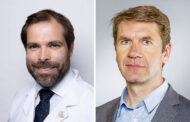Despite significant advances in therapies, lung cancer remains one of the leading causes of cancer-related deaths worldwide. Biomarkers for stratifying risk of progression from benign to malignant lesions are needed for improving early detection and long-term outcomes.
In the first hands-on workshop at WCLC 2024, an expert panel from the US National Cancer Institute’s Early Detection Research Network (EDRN) Lung Group took a deep dive into the multistep process and purpose of biomarker discovery in early lung cancer detection—initial identification of a biomarker that may improve diagnostic accuracy, model development and calibration, assessment of reclassification potential and clinical utility, and ultimately, application in clinical trials and routine practice.
Panelist Stephen Deppen, PhD, Associate Professor, Department of Thoracic Surgery, Vanderbilt University Medical Center, and Co-Director of the EDRN Lung Group’s National Clinical Validation Center, set the stage by addressing the fundamental question and challenge in the early detection biomarker space, stating, “Unlike in the post-treatment setting, in early detection we are looking for a very small signal in a very noisy and dynamic environment, especially in the setting of non-invasive disease and early diagnosis.”
The high degree of biological heterogeneity in lung cancer, from the histopathological and molecular correlates of different subtypes to the disease course and prognosis, adds to the complexity of identifying a biomarker signal.
Dr. Deppen highlighted the different practical aspects along the continuum—from no cancer to a lung nodule to a confirmed malignant lesion—that need to be considered when developing biomarkers. He said that the value added by the biomarker in the clinical decision-making process ultimately determines its uptake in practice.
Another panelist, Michael Kammer, PhD, Assistant Professor, University Cancer Institute of Toulouse, France, used examples from his work to demonstrate how biomarkers can be combined to develop clinical prediction models for fine-tuning risk stratification of indeterminate pulmonary nodules. He also outlined the numerous challenges in the design and conduct of biomarker clinical trials for early lung cancer detection and diagnosis. While individualization of interventions is a clinically valid and welcome approach in routine practice, the variations between “standard of care,” “usual care,” and “suggested care” add to trial design complexity.
Dr. Kammer said that it is important to understand the prevalence of the biomarker in the disease setting to appropriately calibrate risk prediction models. He also noted that diagnostic accuracy and reclassification, while necessary components for establishing clinical utility of biomarkers, are in themselves not patient outcomes.
Anna Barón, PhD, and Alexander Kaizer, PhD, both professors in the Department of Biostatistics and Informatics at the University of Colorado, Denver, explored the calibration of risk models, risk reclassification based on biomarkers, and study design considerations in further detail.
A key theme of the workshop: Recalibration of risk prediction models based on the prevalence of the risk factor/biomarker in the specific disease setting of interest is paramount.
Dr. Barón used simulated examples to demonstrate how risk model attributes can be adjusted to account for differences in biomarker prevalence between training and testing datasets.
Yency Forero, MD, Radiology Fellow at Vanderbilt University Medical Center, focused on the role of radiomic biomarkers in lung cancer detection. She discussed how the accuracy, sensitivity, specificity, and area under the curve of commercially available validated radiomics platforms perform with different risk thresholds. For instance, higher sensitivity would be preferred in scenarios where early detection is crucial.
Dr. Forero explored how machine learning approaches can be applied to address the challenges of inter-study, inter-patient, and intra-patient variations in radiomic findings. She concluded by alluding to ongoing efforts to standardize and harmonize methods for radiomic data collection and analysis.
In the hands-on segment of the workshop, Dr. Kammer led the audience through a biomarker discovery and validation exercise, with stepwise instructions on how to apply scripts to a dataset and generate publishable figures of validated clinically meaningful biomarkers. Karen Anderson, MD, PhD, Professor, School of Life Sciences, Arizona State University, rounded out the session with an exploration of the practical challenges in biomarker validation.





